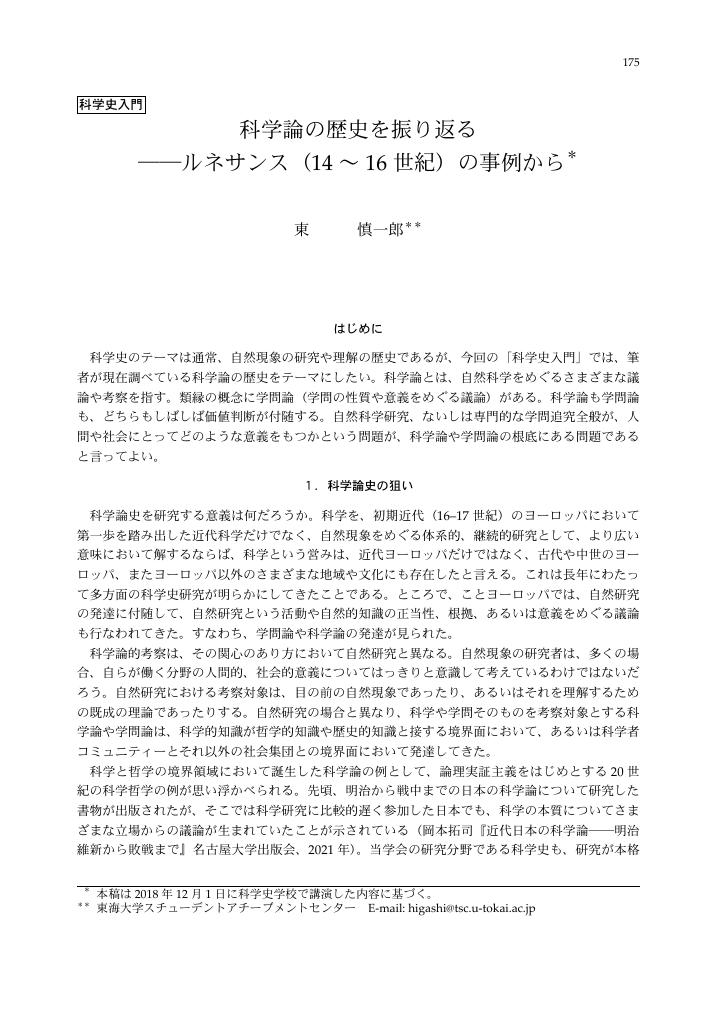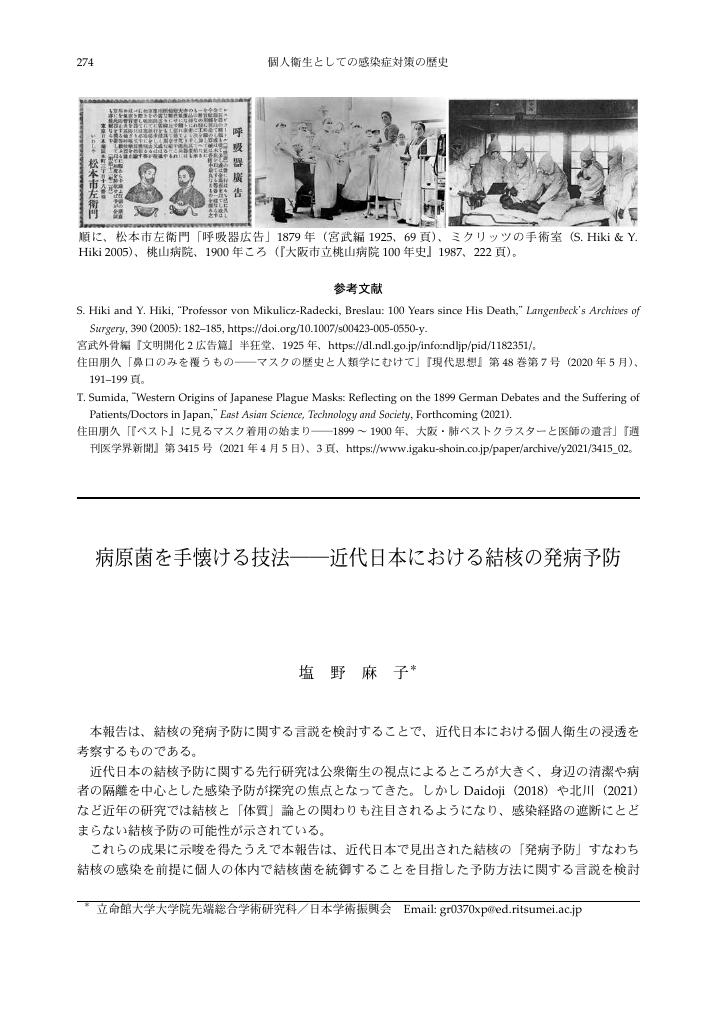3 0 0 0 OA 博物図譜でたどる明治の科学系博物館資料(科学史入門)
- 著者
- 原田 紀子
- 出版者
- 日本科学史学会
- 雑誌
- 科学史研究 (ISSN:21887535)
- 巻号頁・発行日
- vol.43, no.231, pp.161-164, 2004 (Released:2021-08-12)
3 0 0 0 OA 冷戦期アメリカの対日外交政策と日本のテレビジョン放送導入
- 著者
- 奥田 謙造
- 出版者
- 日本科学史学会
- 雑誌
- 科学史研究 (ISSN:21887535)
- 巻号頁・発行日
- vol.46, no.241, pp.1-13, 2007 (Released:2021-08-11)
The plans for TV broadcasting emerged in Japan when Japan and the US began to negotiate a peace. There were two institutions in Japan that promoted TV broadcasting : NHK, a public radio broadcasting station, and Yomiuri Shinbun, a private daily owned by Shoriki Matsutato. At that time the US was looking for new allies and new ways to block the spread of communism. Then American politicians such as Senator Karl Mundt came to understand that television was a useful tool of psychological warfare against communism. When Hidetoshi Shibata, one of Shoriki's best confidants, found a news report of Mundt's "Vision of America " proposal in the US Senate Congress, he thought that it was a good opportunity for giving a push to a scheme for a new Japanese TV broadcasting. Shibata visited the US in April 1951, met Mundt and others, and asked for their support to Yomiuri's plan. Soon after that Shoriki established Nippon Television Network Corporation (NTV), and invited American TV consultants to Japan. They argued that the Japanese TV system should adopt the American TV standards. In September the Sun Francisco Conference was held for the Treaty of Peace with Japan that led to the termination of the occupation. A report of the US State Department one month after the conference said that Japanese supported the American standards for implementation of the peace treaty and defensive alliance, and by television the Japanese nation would be welded into a democratic ally of the US. With the American standards NHK began its TV broadcasting service in February 1953, and NTV, in August.
3 0 0 0 OA 科学論の歴史を振り返る : ルネサンス(14~16世紀)の事例から
- 出版者
- 日本科学史学会
- 雑誌
- 科学史研究 (ISSN:21887535)
- 巻号頁・発行日
- vol.60, no.298, pp.175-181, 2021 (Released:2022-08-01)
3 0 0 0 OA 円周率3.14の動揺と3.16の復活の謎
- 著者
- 中村 邦光 板倉 聖宣
- 出版者
- 日本科学史学会
- 雑誌
- 科学史研究 (ISSN:21887535)
- 巻号頁・発行日
- vol.23, no.151, pp.140, 1984 (Released:2021-04-07)
3 0 0 0 OA 原子爆弾と戦争廃絶・放棄論1945~1946
- 著者
- 山崎 正勝
- 出版者
- 日本科学史学会
- 雑誌
- 科学史研究 (ISSN:21887535)
- 巻号頁・発行日
- vol.58, no.290, pp.162-177, 2019 (Released:2021-01-24)
The "Russell-Einstein Manifesto" issued in 1955, a year after the Bikini incident, called upon the world for the abolition of nuclear weapons and war. It is well known that a similar assertion was made in a journal article in 1946 by Yoshio Nishina, one of Japanʼs prominent nuclear physicists who officially studied the damage of the atomic bombings of Hiroshima and Nagasaki. This paper shows that there were a wide range of arguments in Japan for the abolition and/or renunciation of war in the immediate aftermath of the atomic bombings. Naruhiko Higashikuni, the first Prime Minister after Japanʼs surrender, suggested the idea of "Peaceful Country Japan [Heiwa kokka Nippon]." Tanzan Ishibashi, an influential journalist and future Prime Minister in the 1950s, witnessed a drastic change in international relations caused by the atomic bomb, calling for Japan to become a "warrior for world peace [Sekai heiwa no senshi]." Kanji Ishihara, a former Army lieutenant general and military philosopher, understood that the emergence of atomic bombs and the pursuit of world peace under the United Nations after World War II as a sign of "world political unity [seijiteki sekai toitsu]" that he had anticipated prior to the war. Realizing that the atomic bomb had changed the way of war, Kijuro Shidehara, Prime Minister after Higashikuni, spoke to Supreme Commander of the Allied Forces Douglas MacArthur of the necessity of abolishing and renouncing war. MacArthur incorporated this idea into his demands concerning Japanʼs constitutional revision. All these individuals foresaw the meaning of Article 9 of the Japanese Constitution in the context of the nuclear age, hoping that Japan would be a pioneer of war abolition and renouncement.
3 0 0 0 OA 病原菌を手懐ける技法――近代日本における結核の発病予防
- 出版者
- 日本科学史学会
- 雑誌
- 科学史研究 (ISSN:21887535)
- 巻号頁・発行日
- vol.60, no.299, pp.274, 2021 (Released:2022-08-01)
3 0 0 0 OA NASAとアポロ計画(科学史入門)
- 著者
- 佐藤 靖
- 出版者
- 日本科学史学会
- 雑誌
- 科学史研究 (ISSN:21887535)
- 巻号頁・発行日
- vol.49, no.253, pp.22-25, 2010 (Released:2021-08-02)
3 0 0 0 OA マントヴァのガリレオ
- 著者
- 田中 一郎
- 出版者
- 日本科学史学会
- 雑誌
- 科学史研究 (ISSN:21887535)
- 巻号頁・発行日
- vol.48, no.250, pp.120-123, 2009 (Released:2021-08-04)
3 0 0 0 OA コントと生物学者たち
- 著者
- 金森 修
- 出版者
- 日本科学史学会
- 雑誌
- 科学史研究 (ISSN:21887535)
- 巻号頁・発行日
- vol.33, no.189, pp.7-14, 1994 (Released:2021-03-22)
3 0 0 0 OA 初期ガリレオにおける の法則と加速運動
- 著者
- 山崎 正勝
- 出版者
- 日本科学史学会
- 雑誌
- 科学史研究 (ISSN:21887535)
- 巻号頁・発行日
- vol.29, no.175, pp.167-171, 1990 (Released:2021-08-30)
In his letter to Guidobardo Del Monte in 1602, Galileo Galilei claims that he derives the law of conjugate chords, Prop. 36 in Two New Sciences III. M. Yoshinaka, W. L. Wisan and S. Ito suggest that Galileo obtains the law of conjugate chords from the mean proportional theorem just like in Two New Sciences. In this paper it is shown that the law of conjugate chords can be derived from the theorem of De Motu. The historical significance of the laws of chords and conjugate chords is discussed and it is maintained that these laws are the link that joined old Aristotelian to new Newtonian dynamics.
3 0 0 0 OA 新島襄と科学
- 著者
- 島尾 永康
- 出版者
- 日本科学史学会
- 雑誌
- 科学史研究 (ISSN:21887535)
- 巻号頁・発行日
- vol.25, no.158, pp.83-88, 1986 (Released:2021-04-05)
3 0 0 0 OA 『物理階梯』の編者片山淳吉の生涯
- 著者
- 岡本 正志
- 出版者
- 日本科学史学会
- 雑誌
- 科学史研究 (ISSN:21887535)
- 巻号頁・発行日
- vol.24, no.154, pp.84-94, 1985 (Released:2021-04-07)
3 0 0 0 OA 科学史入門 なぜ石原純か
- 著者
- 西尾 成子
- 出版者
- 日本科学史学会
- 雑誌
- 科学史研究 (ISSN:21887535)
- 巻号頁・発行日
- vol.57, no.287, pp.226-233, 2018 (Released:2021-01-24)
3 0 0 0 東海発電所の安全審査をめぐる論争 : 原子力災害を中心に
- 著者
- 横田 陽子
- 出版者
- 日本科学史学会
- 雑誌
- 科学史研究 (ISSN:21887535)
- 巻号頁・発行日
- vol.59, no.293, pp.1-17, 2020 (Released:2021-01-24)
This paper examines controversy during the safety examination of the first commercial nuclear power plant (NPP) in Japan, the Tokai Nuclear Power Plant, focusing on the issue of major accidents. Politicians, bureaucrats, business leaders, and engineers generally pushed for the plantʼs construction, while scientists̶mainly physicists̶opposed it. At the time, nuclear power technology was a rapidly growing field, with the knowledge of its safety yet to be established. The controversy revolved around four key issues: 1) how to develop NPP technology; 2) how to mitigate the risk of a major accident; 3) how to estimate the potential effects of such an accident on people; and 4) how to determine the "safety" of NPPs. In addressing these issues, scientists consistently upheld the three basic principles on nuclear research and development in Japan, namely democracy, independence, and public disclosure, emphasizing the importance of free discussion and rigorous scientific standards. By contrast, advocates of power plants opposed such an approach and supported the approval of the construction plan on the basis of administrative procedures. In this way, the knowledge on reactor and radiation safety offered by scientists was intentionally and politically disregarded.
3 0 0 0 小特集 日独中における産業IoTの展開と科学技術体制
- 著者
- 中村真悟、杉本通百則、永島昴、藤谷麻菜、山崎文徳、兵藤友博、高橋信一、田口直樹
- 出版者
- 日本科学史学会
- 雑誌
- 科学史研究 (ISSN:21887535)
- 巻号頁・発行日
- vol.59, no.295, pp.215-221, 2020 (Released:2021-01-24)
- 著者
- 廣川 和花
- 出版者
- 日本科学史学会
- 雑誌
- 科学史研究. [第Ⅲ期] = Journal of history of science, Japan. 日本科学史学会 編 (ISSN:21887535)
- 巻号頁・発行日
- no.271, pp.293-295, 2014-10
2 0 0 0 OA ホイヘンスの確率論について
- 著者
- 長岡 一夫
- 出版者
- 日本科学史学会
- 雑誌
- 科学史研究 (ISSN:21887535)
- 巻号頁・発行日
- vol.21, no.142, pp.88-97, 1982 (Released:2021-05-13)
- 著者
- 住田 朋久
- 出版者
- 日本科学史学会
- 雑誌
- 科学史研究 (ISSN:21887535)
- 巻号頁・発行日
- vol.61, no.301, pp.71-77, 2022 (Released:2023-11-17)
2 0 0 0 OA 1930年代日本における科学者の論壇進出と戸坂潤の「文藝学」構想
- 著者
- 加藤 夢三
- 出版者
- 日本科学史学会
- 雑誌
- 科学史研究 (ISSN:21887535)
- 巻号頁・発行日
- vol.61, no.303, pp.199-214, 2022 (Released:2023-11-17)
1930 年代、それまで専門知の探究に力を注いでいた職業科学者たちが、同時代論壇への参入を通じて社会参画の意思を志すようになった。この動きは、高尚な人格と洞察能力を持つ総合的知識人としての科学者像を確立する一方で、結果的に科学振興を目論む統治権力に迎合する側面を持つものでもあった。戸坂潤の批評活動は、こうした科学者と統治権力の協働関係に向けられたものとして理解できる。科学者による公共意識の高まりが、批判精神を欠いたままに帝国日本への国策貢献と接続してしまう事態に対して、戸坂は警鐘を鳴らしていた。このような共犯関係を回避するためには、公共的な有用性とは異なる個別具体的な視点を持つことが重要であり、ゆえに巷間の科学者に「文学」に携わることを積極的に奨励していた。戸坂は「文学」の解釈・吟味を通じて認識論的な思索を深める企てを「文藝学」と呼び、そこに時局の政治力学とは異なる知的対話の契機を探ろうとしていた。
2 0 0 0 OA 名古屋大学プラズマ研究所構想の背景と立案
- 著者
- 雨宮 高久
- 出版者
- 日本科学史学会
- 雑誌
- 科学史研究 (ISSN:21887535)
- 巻号頁・発行日
- vol.61, no.302, pp.105-121, 2022 (Released:2023-11-17)
Within the general history of fusion research in Japan regarding the decision for the A-B plans dispute during 1959, the B-plan (promptly building medium-sized devices that had obtained some success in foreign countries) was postponed. Furthermore, it was decided that the national policy for fusion research in Japan would start with basic research using the Ministry of Education, Science and Culture (MoE) budget. Accordingly, it was decided that the Institute of Plasma Physics (IPP) at Nagoya University would bear the responsibilities and consequences of the A-plan (promoting the basic research to develop the original ideas). However, our research concludes that the IPP is related to not only the A-plan but also the B-plan. Kodi Husimi, the chairman of Kakuyugo Tokubetsu-Iinkai [Special Committee for Nuclear Fusion (SCNF)], and Eiichi Kawasaki, the secretary of SCNF, were planning to reconcile the opposing opinions regarding the B-plan. To find a solution, they planned an informal gathering of researchers which was held on June 21, 1959. After an informal gathering, the opposing plan of B-plan was to establish the institute under the jurisdiction of the MoE proposed by Kawasaki. Kawasakiʼs plan was a reasonable compromise, because the institute included assumptions about the construction of the medium-sized devices under the MoE budget. Many researchers agreed to this plan; however, some supporters on the B-plan did not agree inwardly and distanced themselves from the IPP.










